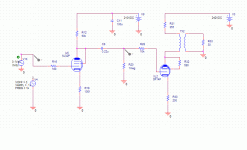Hi,
I spent the last week modifying a 12ax7-el84 headphone amp. The major change is replacing the 12ax7 with ef86 and getting ride of the nfb. The project went fine and the amp is now working fine. There are still a few things I want to improve. The first one is I need to reduce the gain. It is way too sensitve to vol control and the normal listening level is at 9 o'clock.
I want to keep the idle current (ef86 @ 1.8ma, el84@35ma) as it is. Any suggestion as to reduce the overall gain? The schematic is below:
I spent the last week modifying a 12ax7-el84 headphone amp. The major change is replacing the 12ax7 with ef86 and getting ride of the nfb. The project went fine and the amp is now working fine. There are still a few things I want to improve. The first one is I need to reduce the gain. It is way too sensitve to vol control and the normal listening level is at 9 o'clock.
I want to keep the idle current (ef86 @ 1.8ma, el84@35ma) as it is. Any suggestion as to reduce the overall gain? The schematic is below:
Attachments
pftrvlr said:getting ride of the nfb.
The lack of a cathode bypass caps implies some local nfb. Whether this is bad or not is up to you, but it is there (and it reduces gain.)
Anyhow, you could swap the output tubes for some 12B4's, or you could shunt the volume pot by putting a resistor (about equal to the pot resistance) in series with the pot's input. Or you could add a resistor connecting C8 with R20 to build a voltage divider (which is similar to the shunted pot, just in a different place). Lower R20 to 500K and use a 500K for the series resistor. Or, you could just drop the driver altogether -- not sure why you would need it for a headphone amp.
GordonW said:One other idea- try running the EF86 in triode mode. This will drop the gain significantly.
According to his schema he already is...
dave
Congratulations;
replacing the tube you got more gain so GNFB may be deeper now that means less distortions and better sound if to compare against "slight" GNFB that is enough to make a specter of distortions wider, but is not enough to bring level of distortions down. A negative feedback in tube amps is such sharp thing so you have only 2 options: use it as deep as possible, or do not use at all. To prevent oscillations you may need an additional minimal possible capacitor from anode of the 2'nd toob to cathode of the 1'st.
replacing the tube you got more gain so GNFB may be deeper now that means less distortions and better sound if to compare against "slight" GNFB that is enough to make a specter of distortions wider, but is not enough to bring level of distortions down. A negative feedback in tube amps is such sharp thing so you have only 2 options: use it as deep as possible, or do not use at all. To prevent oscillations you may need an additional minimal possible capacitor from anode of the 2'nd toob to cathode of the 1'st.
- Status
- This old topic is closed. If you want to reopen this topic, contact a moderator using the "Report Post" button.
- Home
- Amplifiers
- Tubes / Valves
- EF86-EL84: too much gain!
